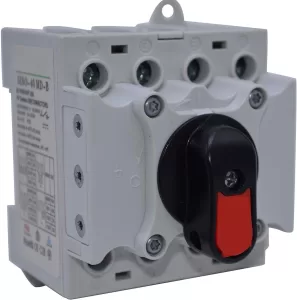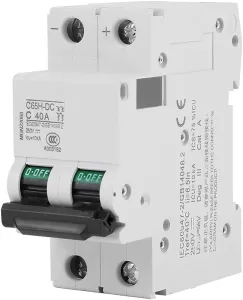
Isolator vs Circuit Breaker: What’s difference between them?
November 23 2023  1531
1531
Inquiry
Global electronic component supplier AMPHEO PTY LTD: Rich inventory for one-stop shopping. Inquire easily, and receive fast, customized solutions and quotes.
QUICK RFQ
ADD TO RFQ LIST
A crucial distinction exists between isolators and circuit breakers: isolators are used to isolate equipment from the power source, whereas circuit breakers are used to protect equipment from overcurrent faults. Isolators and circuit breakers are both essential parts of electrical systems that safeguard personnel and equipment from electrical hazards. In this blog, we will delve into the world of isolators and circuit breakers, exploring their functions, applications, and differences. We will also answer some frequently asked questions about these essential electrical components.
What is an Isolator?
An isolator, also called a disconnect switch, is a type of electrical device that is used to isolate or disconnect a circuit from the power source. Unlike circuit breakers, isolators are only meant to be used when there is no current flowing through the circuit; this feature makes them perfect for use during maintenance and repair procedures as it guarantees that electrical circuits are fully de-energized before personnel work on them.
Why Isolator is Used?
Isolators are used for a variety of reasons, including:- To protect equipment from overcurrent faults.
- To isolate equipment from the power source for maintenance or repair.
- To prevent accidental energization of equipment.
What is a Circuit Breaker?
A circuit breaker, on the other hand, is designed to protect electrical circuits from overcurrent conditions. When a circuit's current flows beyond its safe operating limits, overcurrent occurs. Many things, including short circuits, overloads, and equipment malfunctions, can cause this. Circuit breakers guard against possible fire hazards and damage to the circuit by automatically detecting and stopping the flow of current.
Why Circuit Breaker is Important?
In addition to helping to prevent electrical shock, circuit breakers safeguard equipment from overcurrent faults, which can harm equipment and start fires.Isolator vs Circuit Breaker
| Feature | Isolator | Circuit Breaker |
| Purpose | Circuit isolation | Overcurrent protection |
| Operation | Manual | Automatic |
| Usage | Maintenance, repair, installation | Overcurrent protection |
| Current interruption | Off-load | On-load |
Video related to Isolator vs Circuit Breaker
How Isolator works?
- Preparation: Prepare by turning off the main power supply or the breaker for the circuit you want to isolate. This will ensure that the electrical system is de-energized. This important step guarantees safe operation and removes the possibility of electrical shock.
- Locate the Isolator: Find the circuit you wish to isolate's isolator. Isolators are usually found inside electrical panels or close to the equipment they are meant to safeguard.
- Verify Off-Load Condition: Before using the isolator, make sure the circuit is completely dead. Measure the amount of current passing through the circuit using a multimeter or electrical tester. It is safe to move forward if the current is zero.
- Open the Isolator: The method for opening an isolator varies depending on its type. To disconnect the circuit on a manual isolator, find the switch or lever and turn it. In the case of solenoid-operated isolators, the disconnection is triggered by energizing the solenoid coil during the opening process.
- Visual Confirmation: Make sure the switch or lever is in the "off" position by visually inspecting it after the isolator has been opened. This attests to the circuit's total isolation and the absence of current.
- Proceed with Maintenance or Repairs: You can now safely isolate the circuit and work on it without running the risk of receiving an electrical shock while doing so.
- Restore Power: Make sure the circuit is correctly reassembled and connected after any maintenance or repairs are finished. Make sure the isolator is still in the open position, and double-check all connections before turning the power back on.
- Close the Isolator: Once everything is in working order, carefully close the isolator by de-energizing the solenoid coil or manually operating the switch or lever. By doing this, the power source and isolated circuit are reconnected.
- Verify Power Restoration: To verify that power has been restored to the circuit, use an electrical tester or multimeter. In the event that the circuit operates as intended, the maintenance or repair process is successful.
How Circuit Breaker works?
- Normal Operation: The circuit breaker permits unrestricted electrical flow through the circuit when it is in the "on" position. Since the contacts are firmly connected and the bimetallic strip and solenoid coil are in their idle states, current can flow from the power source to the load.
- Overload Detection: In the event of an overload, the bimetallic strip heats up as a result of the increased current flowing through the circuit exceeding its safe operating limit. The switch mechanism activates when the strip bends as it heats up.
- Tripping Mechanism: The tripping process is initiated by the switch mechanism being activated. When the solenoid coil is activated, a magnetic field is produced that pushes the plunger downward and forces the contacts apart. By cutting off the current flow, these contacts are disconnected, thereby closing off the circuit.
- Power Interruption: Power interruption occurs when the contacts are open, cutting off the circuit's connection to the power source and stopping the flow of electricity. This stoppage avoids possible fire risks as well as circuit damage.
- Reset Procedure: The circuit must be de-energized by turning off the main power supply or the breaker for the impacted circuit in order to reset the circuit breaker. By pressing the reset button or lever, the circuit breaker can be reset after the circuit has been de-energized. By doing this, the contacts are brought back to their closed state, restoring the circuit's power.
- Fault Identification: It's critical to determine the source of the overload and take care of the underlying problem after resetting the circuit breaker. This could entail looking for broken wires, malfunctioning appliances, or overloaded outlets.
- Preventive Measures: Adhering to the correct electrical safety guidelines is crucial to preventing overloads in the future. This entails utilizing appliances with the appropriate wattage, avoiding overloading circuits, and routinely checking electrical cords and outlets for wear or damage.
Applications of Isolators
- Electrical maintenance and repair: Isolators are crucial for completely de-energizing circuits before maintenance workers work on them, avoiding electrical hazards, and guaranteeing that the circuits are isolated.
- Electrical installations: Isolators are used to momentarily cut the circuit before connecting the new equipment when installing new electrical equipment.
- Emergency isolation: Isolators can be used to swiftly and safely cut off the impacted circuit in the event of an electrical malfunction or possible hazard.
- Motor control: In order to maintain or repair motors, isolate them from the power source using an isolator.
- Generator transfer switches: When utility power is restored, a generator can be safely connected to a home's electrical system and disconnected using generator transfer switches, which use isolators.
- Solar panel systems: In order to isolate the panels from the inverter for upkeep or repair, isolation devices are used in solar panel systems.
Applications of Circuit Breaker
- Residential electrical systems: To safeguard individual circuits in homes, circuit breakers are installed in residential electrical panels. They protect lighting, appliances, and other electrical equipment from overcurrent situations.
- Industrial control systems: Circuit breakers guard delicate machinery and equipment against overcurrent damage in industrial settings. They guarantee the dependability and safety of industrial processes.
- Commercial buildings: Offices, retail establishments, and other commercial settings depend on circuit breakers to protect their electrical systems. They avert possible fire risks and operational disruptions.
- Motor control: To safeguard motors against overcurrent situations, circuit breakers are employed in motor control circuits. They guarantee that machinery operates smoothly and prevents motor burnout.
- Electrical panels: The main safeguards in electrical panels are circuit breakers, which offer overcurrent protection for different circuits. They are an essential component of systems for distributing electricity.
- Portable generators: Circuit breakers are used in portable generators to prevent overcurrent situations and safeguard the generator and any connected devices. They guarantee portable power sources operate safely and dependably.
Conclusion
Isolators and circuit breakers are two crucial parts of electrical systems. They are essential in shielding workers and equipment from electrical risks. We have discussed the uses, distinctions, and capabilities of isolators versus circuit breakers in this blog post. In addition, we have addressed a few commonly asked queries concerning these crucial electrical parts.Populer Posts
5SGSED8K2F40C2LG
Intel
5SGSED8N2F45I3G
Intel
5SGSED8N3F45C3G
Intel
XC3190-PQ160IPH
AMD
5SGXMA4K2F35C1G
Intel
EP2AGX190FF35I3G
Intel
EP2AGX260EF29I3
Intel
A42MX09-PQG144M
Microchip Technology
5SGXEA3K2F35I3G
Intel
1SG165HN2F43I2VG
Intel
